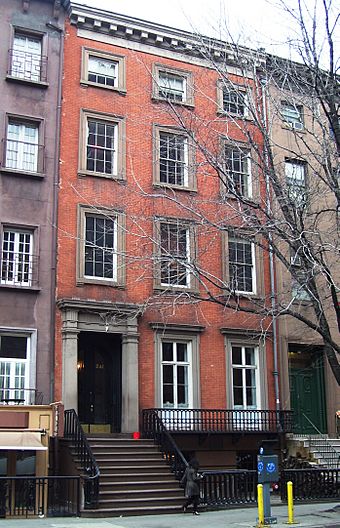Norwood Club facts for kids
|
Andrew Norwood House
The Norwood Club |
|

(2011)
|
|
| Location | 241 West 14th Street Manhattan, New York City |
|---|---|
| Built | 1845-1847 |
| Architectural style | Greek Revival Italianate |
| NRHP reference No. | 79001606 |
Quick facts for kids Significant dates |
|
| Added to NRHP | July 9, 1979 |
The Norwood Club was a special private club in the Chelsea area of Manhattan in New York City. It was started in 2007 by Alan Linn and Steve Ruggi. They wanted it to be a modern version of old-fashioned gentlemen's clubs. The club was for people interested in arts and creative work. Alan Linn called it a "club for the curious." Members of the Norwood Club could also visit other private clubs around the world. These clubs were in places like London, Paris, and Shanghai. The club closed in February 2022.
Contents
The Norwood Club Building
The Norwood Club was located in a five-story brownstone building. This building is at 241 West 14th Street in Manhattan. It was built in 1847 for a businessman named Andrew S. Norwood. The building is also known as the Andrew Norwood House. In the 1840s, this area of Manhattan was very fashionable.
Andrew Norwood built three matching houses on West 14th Street. These were the first brick homes on that street. They were designed in the Italianate style with some Greek Revival details. Norwood and his family moved into the Norwood House in 1847. The other two houses were sold by 1853. One of them later became a secret club called the Tammany Tough Club. Andrew S. Norwood's son, Andrew G. Norwood, inherited the home in 1858. The family owned the house until around 1900.
Later Uses of the House
Over the years, the house was used for many different things. It was a boarding house, a home for church workers, and even a funeral home. In 1976, a man named Raf Borello bought the house. He restored it and lived there until he passed away in 2005. During this time, the outside of the building was given special landmark status.
In 2006, Borello's family sold the house to a group that included Alan Linn. Linn then founded the Norwood Club there. A British interior designer named Simon Costin helped to change the space. He made sure to keep its artistic and historical feel. The Norwood Club opened its doors in 2007.
Inside the Norwood House
The Norwood House has many beautiful features. It has 13 marble fireplaces and mahogany wooden doors. There are fancy plaster designs on the ceilings. The house also has a cast iron balcony and a graceful curving staircase. A colorful stained glass skylight lets light into the building.
When it was open, the Norwood Club had a restaurant and two lounge bars. It also had a screening room for movies and a garden with seating. The top floor had the screening room and a small roof deck. A secret door on the main floor led to a lower dining room. Members could use this room for private events. The entire club displayed paintings, drawings, and sculptures. These art pieces were changed once a year. Many of the artworks and books came from the club's own members.
Landmark Status
The Norwood House has been a New York City Landmark since 1978. It was also added to the National Register of Historic Places in 1979. It is one of the few old townhouses of its kind still standing in Manhattan. In December 2020, the building was put up for sale.
Membership
Joining the Norwood Club was not easy. People had to apply and answer questions about their interests in the arts. They also had to explain why they wanted to join. An interview and a tour of the club were also required. The club had about 1100 members. There was also a waiting list for new people who wanted to join.
See also
 In Spanish: Casa Andrew S. Norwood para niños
In Spanish: Casa Andrew S. Norwood para niños
- List of traditional gentlemen's clubs in the United States
- List of New York City Landmarks
- National Register of Historic Places listings in New York County, New York


